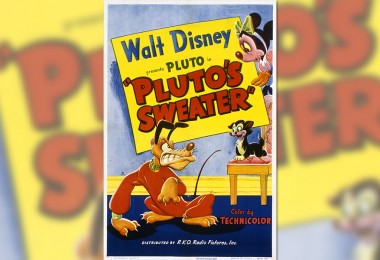Mickey’s true color debut came in 1932’s Parade of the Award Nominees, a short film made for that year’s Academy Awards banquet. Wearing green shorts and yellow gloves—a standard color scheme on many toys at the time—Mickey led Minnie, Clarabelle Cow, and the Oscar nominees of 1932 as they marched through a fairytale forest. Marie Dressler (Emma) brought up the rear, carrying a suitcase from which a stray alarm clock dragged. A gray-furred, oddly monochromatic Pluto sniffed along the clock’s trail, just as he’d tracked a similar clock in Just Dogs (1932).
But then why is The Band Concert often referred to Mickey’s first appearance in color?
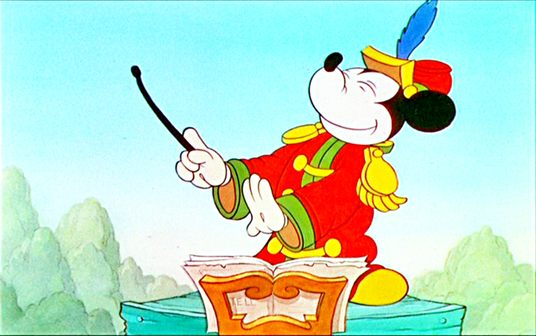
Award Nominees may have beaten The Band Concert to the color punch. But Band Concert was the first regular Mickey cartoon in color—and comparing it to Award Nominees shows us just what decisions were involved in adapting to color on a more permanent basis.
Mickey’s shorts had been both red and green in merchandise, but they were more often red, so Band Concert decisively made red Mickey’s signature color. In another change from Award Nominees, no character in Mickey’s Band Concert world was gray anymore. In 1935, Disney held an exclusive contract on Technicolor’s three-strip process, giving him more colors to work with than other studios had. Why not indulge? Indeed, The Band Concert‘s color level was matched only by its excitement level!
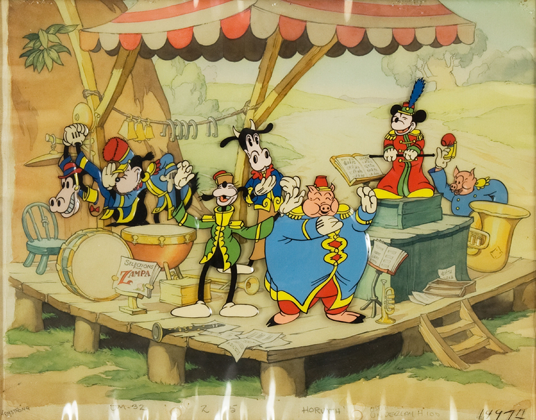
When 1940s bandleaders spoke of “Mickey Mouse music,” it wasn’t a compliment. They were simply referring to trite, noisy dance-band tunes that brought generic cartoons to mind. Of course, we know that classic Mickey cartoons were never generic, nor were their scores! Mickey himself was often shown as a genuinely cultured “performer” and real Mickey Mouse music—as orchestrated by studio musicians like Carl Stalling and Leigh Harline—covered everything from bracing classical tunes to vibrant jazz. In 1935, Gioachino Rossini’s “William Tell” overture provided the theme for Mickey’s most memorable musical epic: The Band Concert!
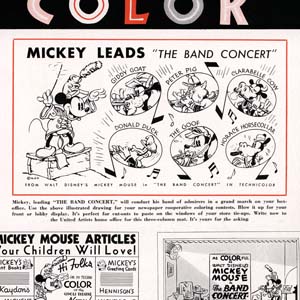
The story finds Mickey’s orchestra performing in the park; the group includes conductor Mickey, Goofy on clarinet, Clarabelle on flute, Horace on drums, Peter Pig on trumpet, little Paddy Pig on tuba and a whiskery dog on trombone. Finishing Louis Hérold’s “Zampa,” the band begins “William Tell,” but is heckled by snack salesman Donald Duck. Playing “Turkey in the Straw” on a fife, Donald tricks the band into playing it too! Irate Mickey breaks Donald’s fife, but the Duck has an unending backup supply. Then two other menaces confront the band: a pesky bee and a raging cyclone that carries Mickey’s gang into the sky. But gutsy Mickey finishes the midair overture and brings everyone down to earth, even if only Donald is left to cheer.
Helmed by future Snow White director Wilfred Jackson, this storyline brought out the best in Disney’s staff—and his stars. Animator Les Clark recalled being put in charge of Mickey because some of his peers’ Mickeys were “stiff and had no fluidity.” Clark’s bouncier Mouse was perfect for Band Concert; as he fought to conduct his motley crew, his frustration—with Donald, with everything—became sympathetic as well as funny. But Dick Huemer’s Donald was sympathetic, too. Mugging gleefully at viewers, Donald hinted that Mickey’s overachieving gang was just asking to be pranked… and audiences had to agree! Icing on the cake was Ferdinand Horvath’s opening scene, introducing the band with the perfect mix of pomp, energy, and silliness. Famed illustrator Horvath, better known as a concept artist, got a plum of an animation assignment.
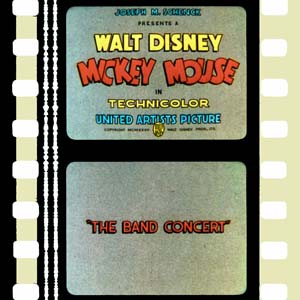
The Band Concert was a plum itself. Mickey’s full-time switch to color made Disney the first all-color cartoon studio; a milestone emphasized in a special bulletin from distributor United Artists. The bulletin was followed by an oversized press kit, laden with detail—and a few bloopers: Giddy Goat, a bumpkin bit-player from the comics, was announced as part of Mickey’s band, even though he was replaced by the dog trombonist in the film. Other aspects of the press kit are equally amusing to modern eyes, including the suggestion that paint stores cross-promote the film with their products—all the better to sell color to viewers. The press was sold, too. The New York Times admired “Mickey Mouse fall[ing] under Technicolor’s sway.” Vogue magazine noted that “we shall not soon forget the epic figure of Horace at the kettle-drums in The Band Concert…” The film was still a legend years later, leading to its reissue with refilmed opening titles. Modern TV and video releases use the reissue print, so fans generally haven’t seen the original title designs since the 1930s.
Music, Mousetro—please!



